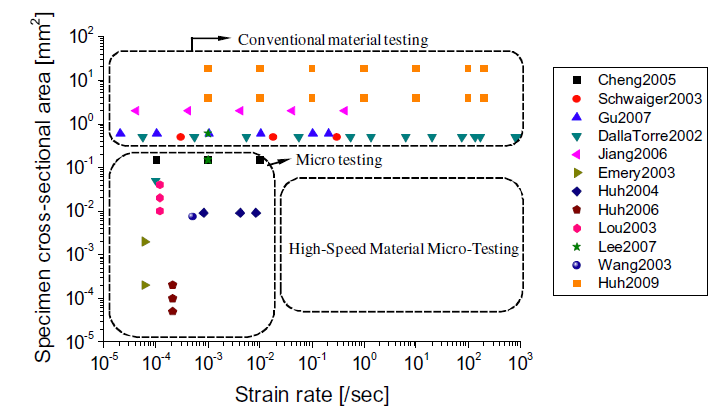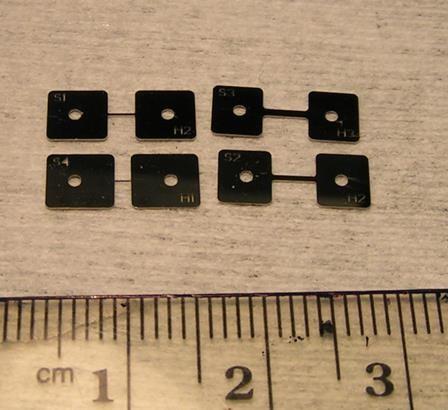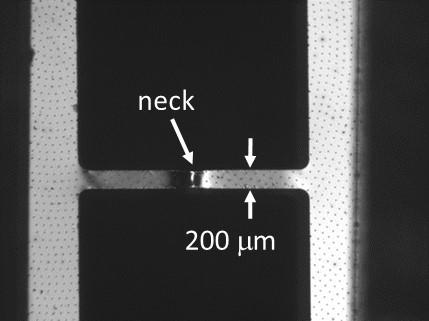Summary
We develop methods to evaluate the mechanical behavior of micro- and mesoscale metal alloys to fracture, and Micro Electro Mechanical Systems (MEMS) materials reliability, for various structural applications:
- Conventional mechanical test methods face limitations when specimens are smaller than a few millimeters in length, but information at this scale is needed for many advanced applications. We develop new measurement techniques and instruments to accurately evaluate the mechanical properties of micro and mesoscale volumes of material
swith a special emphasis on time-dependent behavior. Testing of micro and mesoscale specimens will yield critical information about material behavior and reliability inaccessible with conventional macroscale tests. Other advantages include the potential for in-situ environmental testing and high-throughput, massively parallel testing for generating statistically significant material data. Industries that will benefit from this approach include manufacturing, energy, medical devices, sensors and microelectronics. - We are developing techniques and instrumentation for evaluating the structural reliability of MEMS at cryogenic temperatures, for industries such as quantum computing.
Description
Knowledge of a material’s mechanical properties is key to designing safe and reliable structural components for applications ranging in size from medical implants to large civil engineering structures. Traditionally, a material’s mechanical properties are measured by performing mechanical tests on specimens from a few millimeters to many meters in length, with test equipment of corresponding sizes.
![Example cross section of a weld [1] with sketches of micro specimens that could potentially be extracted from the different regions and individually tested for mechanical properties.](/sites/default/files/styles/480_x_480_limit/public/images/2017/02/27/examplesectionofweldwithmicrospecimens.jpg?itok=KQDIgNe3)
Scaling specimen sizes down to the millimeter (mesoscale) or the micrometer scale is beneficial for many applications, but also presents new challenges. Numerous industries utilize structural components or have critical features that are smaller than can be evaluated using conventionally sized approaches. For example, the strength of welds and solder joints are strongly tied to the micrometer-scale spatial variation of the alloys’ microstructure and composition. Measuring the local properties at different mesoscale regions of these structures will provide more complete understanding of their behavior and improve manufacturing reliability. This is especially pertinent to the electronics manufacturing industry where lead-based solders have been replaced by newer solder alloys whose properties are still not as well understood. Other applications involve testing of specimens comparable in size to small load-bearing components such as the mechanical parts in electronics packages, medical implants, and Micro Electro Mechanical Systems (MEMS) devices, to obtain more accurate properties.
Small specimens are also highly conducive to in-situ testing in harsh environments such as extreme temperatures (hot or cold), exposure to corrosive chemicals or exposure to radiation. Mesoscale specimens allow for safer in-situ environmental tests, and allow more tests to be performed when the volume of material may be limited, such as materials from in-service components. Testing of mesoscale specimens can therefore help accelerate the development of advanced structural materials for applications ranging from nuclear reactors to space satellites.
![Cross section of a SAC solder joint in a BGA [2], with sketches of micro specimens that could potentially be extracted and individually tested to measure spatially varying properties.](/sites/default/files/styles/480_x_480_limit/public/images/2018/08/02/crosssectionsacsolderjoint.png?itok=w5QNPzaX)
Traditionally, efforts to scale down the size of bulk material tests have met with several challenges. Apart from the challenge of fabricating micro and mesoscale specimens, as specimens become smaller than a millimeter it becomes increasingly difficult to handle and grip them, and to apply and measure the loads and displacements. Traditional testing methods do not provide the required level of accuracy and resolution when they are significantly larger than the specimens.
Our goal is to develop new test methods and instruments for measuring time-dependent mechanical properties of micro to mesoscale bulk materials. Our approaches include adapting conventional test methods, as well as developing new table-top test instruments and chip-scale MEMS-based test instruments. Our MEMS-based test techniques have so far demonstrated tests to fracture of among the smallest size specimens (gauge sections) of bulk – not thin film - materials reported in the literature. This capability positions us well for tackling additional challenges such as dynamic testing of micro and mesoscale specimens at high strain rates. Manufacturing applications such as micro metal forming, extrusion and additive manufacturing involve large material deformations at high strain rates. In defense applications, structural components such as armor, ballistics, drones, sensors, electronics and munitions contain small components subjected to high accelerations and impacts. For applications such as these, micro and mesoscale material data at high strain rates is needed for accurate finite element modeling. However, a gap currently exists in the literature on test methods for these sizes and strain rates, as shown in the figure below. Our test approaches could potentially fill this gap.

Finally, as part of a multi-Laboratory effort, we are also developing methods to evaluate the structural reliability of micro-to-mesoscale materials and MEMS devices from room temperature down to cryogenic temperatures. Reliable operation of RF MEMS switches at cryogenic temperatures is critical for replacing conventional switches in superconducting circuits, which drive a range of applications from high-speed telecommunications to quantum computing. Academic research has focused on developing RF MEMS switches with new designs, new materials, and more elaborate fabrication process; however, long-term cryogenic operation and repeated thermal cycling are still known to limit the device lifetime. Commercial RF MEMS switches provide a more cost-effective solution but are designed for ambient conditions and as such there is little/no data available regarding their performance reliability at cryogenic temperature near and below 4 K.
CURRENT EFFORTS
1. Small-scale mechanical testing of metal alloys:
We are currently working with the U.S. Army Combat Capabilities Development Command Armaments Center (formerly Armament Research Development and Engineering Center (ARDEC)) Fuze Division and HT Micro Analytical Inc (Albuquerque, NM) under a Joint Fuze Technology Program (JFTP) funded effort to characterize the dynamic response of microscale nickel alloys for structural analysis codes. ARDEC engineers develop micro mechanical mechanisms fabricated through the LIGA process (Lithographie, Galvanoformung, Abformung) for various applications. It is well known that the properties of materials at the microscale differ from those at the macroscale. To determine formal design margins for these mechanisms, the microscale material’s dynamic response under various loading conditions needs to be understood. NIST is developing test methods and specimen designs to perform tensile, shear and compressive tests at various strain rates and temperatures, and using these test methods to characterize the dynamic behavior of the microscale metal materials. Another objective is to provide test data that is statistically significant and with well-understood experimental uncertainties. The results of this effort will enable engineers to increase the reliability of the micro mechanisms and to understand and recreate device failures using finite element analysis, and will also be broadly applicable to many other applications involving the design and reliability of Micro Electro Mechanical Systems and highly miniaturized structural components.
We have also applied these mesoscale test techniques to additive manufactured bulk metals, in collaboration with the Additive Manufacturing Fatigue and Fracture project. Mechanical testing at the mesoscale allows the effects of microstructural defects and heterogeneities from additive manufacturing processes to be studied in more detail at the appropriate length scales.


2. MEMS reliability at cryogenic temperatures:
We are also investigating the performance and reliability of MEMS switches at cryogenic temperatures as part of a multi-Laboratory effort to develop RF calibrations for scaling up quantum computing. Commercial MEMS switches are integrated in sealed packages which cannot be easily removed nondestructively, thus the MEMS chips cannot be directly accessed to evaluate the accumulation of damage which can alter the switches’ operating characteristics. Furthermore, overall device reliability is also influenced by the package reliability. While these MEMS switches are used for microwave applications, microwave signals provide relatively indirect information on the MEMS structural reliability. We are therefore developing new low-frequency testing methods to evaluate the structural reliability of commercial MEMS switches for cryogenic applications.
REFERENCES
[1] J. Lee, K. Asim, J. Pan, “Failure mechanism of laser welds in lap-shear specimens of high strength low alloy steel,” J. Pressure Vessel Tech. 134(6), 061402, 2012
[2] S.K. Kang, P. Lauro, D.-Y. Shih, D.W. Henderson, J. Bartelo, T. Gosselin, S.R. Cain, C. Goldsmith, K. Puttlitz, T.K. Hwang, W.K. Choi, “The microstructure, thermal fatigue, and failure analysis of near-ternary eutectic Sn-Ag-Cu solder joints,” Mat. Trans., Vol 45, no. 3, pp. 695-702, 2004.
[3] J.S. Kim and H. Huh, “Evaluation of the Material Properties of an OFHC Copper Film at High Strain Rates Using a Micro-Testing Machine,” Exp Mech, 2011.
[4] L.A. Liew, D.T. Read, and N. Barbosa III, “US Army ARDEC Joint Fuze Technology Program (JFTP), Microscale Materials and Energetic Effects Characterization, Task 2 Report: Quasi-Static Tensile Tests,” NIST Interagency/Internal Report (NIST IR) – 8182, 2018.
Publications
Characterizing MEMS Switch Reliability for Cryogenic Applications such as Quantum Computing | NIST
Dominant Factors for Fracture at the Micro-Scale in Electrodeposited Nickel Alloys | NIST
Measuring Flow Curve and Failure Conditions for a MEMS-Scale Electrodeposited Nickel Alloy | NIST
KEYWORDS
structural materials, mechanical testing, materials characterization, energy, infrastructure, electronics, manufacturing, microscale, MEMS, microsystems, cryogenic, materials reliability

